By Selina Kanowitz and Gary Ginsburg
Israel was magical, mystical, and enchanting! From April 20-30, we were honored to participate in the Jewish War Veterans 33rd Allied Mission to Israel with 41 other people.
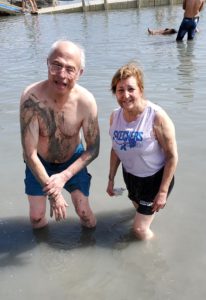
Ginsburg and Kanowitz in the Dead Sea.
We had beautiful weather for our trip to the Dead Sea on Saturday, April 22. Many of us got to walk, talk, float, and splash around in the water at the lowest point on earth. This is probably the closest point on earth to hell. The bottom of the Dead Sea is very muddy in places, and we needed to be careful not to slip and fall.
Later that same day, we stopped at Masada where we were transported to the top by cable car. We were told that it would take several hours to climb to the top of Masada on the pathway. The view of the various camps in the ground and surrounding sights were incredible. Our guide Ronit told us about the various archeological structures and events which took place at Masada.
On Sunday we saw the Dead Sea Scrolls at the Israel Museum in Jerusalem.
“One of the many great points about the JWV Allied Mission to Israel is that we have access to sights and to Israelis that the average tourist does not,” said Past National Commander Harvey Weiner. In Latrun, we visited the Jewish WWII Museum of Heroes, which was not yet open to the public. We had a special tour led by the museum’s CEO, Retired Brigadier General Tzvika Kantor. The museum was still under construction when we had our tour, but it opened to the public in May.
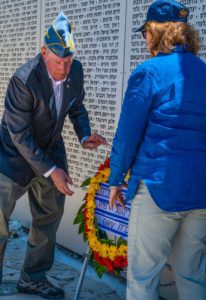
NC Mellitz and Poppe placing memorial wreath.
On Monday, at our hotel, we received an outstanding unclassified briefing from U.S. Army Colonel Phil Messer, our military official assigned to the embassy. This presentation laser focused on the military relationship between the United States and Israel.
We also visited the National Memorial Museum for Israeli Fallen, which honors both military members and civilians.
Our next stop was Yad Vashem. We saw the children’s memorial which has been added to this memorial in Jerusalem. It is a room filled with stars symbolizing the 1.5 million Jewish children murdered in the 1930s and 1940s.
In the evening, we attended the Jewish National Fund (JNF) Yom Hazikaron Ceremony at Ammunition Hill, where we learned about the tactical battle there which led to the unification of Jerusalem in June of 1967. We met Tina Lamm, originally from Long Island, New York, whose husband works with Project Benjamin. Michael Levine, who runs the Lone Soldier Program, also spoke at the ceremony. His program supports about 1,800 IDF personnel who have enlisted from places around the world, but whose family has not officially relocated to Israel.
On Tuesday, we attended a memorial ceremony at the National Memorial Museum in Latrun. As part of the ceremony, National Commander Nelson Mellitz and JWV Massachusetts trip guest, retired Col. Cheryl Poppe laid a wreath at the wall which lists the names of fallen Israeli armor soldiers.
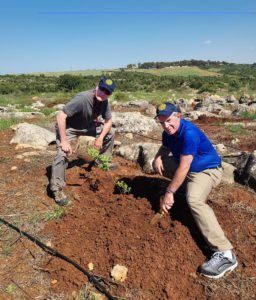
NC Mellitz and Gary Glick planting trees in the Lavi Forest.
At the start of Israel’s 75th Anniversary celebration on Tuesday night, we saw, felt, and heard the all-night party on the beachfront in Tel Aviv. There were quiet fireworks and children spraying silly string throughout the parks to celebrate Yom HaAtzmaut.
The Yom HaAtzmaut celebrations continued Wednesday. “Watching the Independence Day flyover by the Israeli Defense Forces on the beach in Tel Aviv was a thrill for me, being a U.S. Air Force veteran,” said trip participant Robert Newell of the American Legion. Newell went on the trip as a guest of the Department of New Jersey.
We took a bus tour to Jaffa to see many biblical sites, as well as a magnificent view of Tel Aviv.
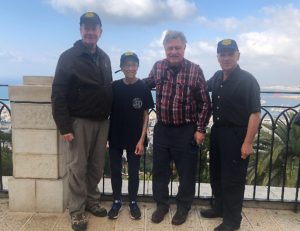
JWV Members who participated in previous Sar-El Missions held a reunion overlooking the Seaport of Haifa, Israel. From left: NC Mellitz, Kathy Brill, PNC Harvey Weiner, and NVC Barry Lischinsky.
Thursday started with a visit to Tzevet, which is an Israeli veterans organization. The organization has approximately 40,000 members but is really for former career IDF personnel. We received a briefing from IDF General Ephraim Lapid (Israeli Intelligence) and his staff.
In Galilee, we planted trees in the Lavi Forest and were blessed that there was no rain at that special moment or 43 people would have been in the mud. This was a modest but positive contribution to the future of the modern state of Israel.
Friday saw our group in the Golan Heights. We learned about and saw evidence of the serious combat operations and armored warfare of the October 1973 conflict.
We arrived in Netanya on Saturday and visited Kibbutz Misgav Am, which is the northernmost Kibbutz in Israel. It was almost close enough to spit or urinate into Lebanon, but you need to check the wind direction first.
We visited the Bahai Gardens in Haifa and stopped in the ancient city of Akko, which is a UNESCO World Heritage Site.
“COVID-19 delayed the 33rd JWV Mission to Israel for several years, but… it was worth the wait,” said Past National Commander Jeff Sacks. “I didn’t think that we could cover so much ground and experience as many things as we in fact did.”
JWV’s Allied Mission Trip to Israel is an unforgettable 10-day journey through the Jewish homeland that none of the participants will ever forget. We encourage all members, and members of our veteran community who are not Jewish to join us next time.
Volume 77. Number 2. 2023
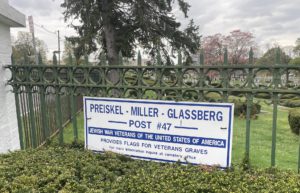 weather beaten flags and JWV markers prior to Memorial Day and Veterans Day.
weather beaten flags and JWV markers prior to Memorial Day and Veterans Day.
